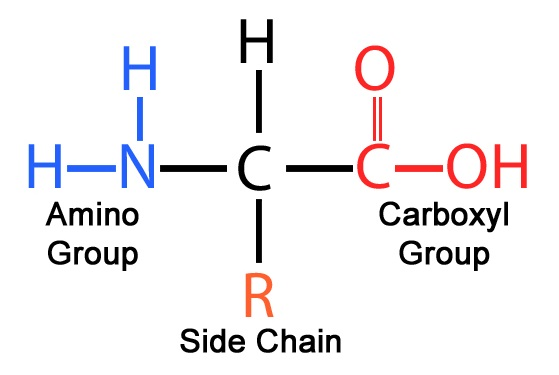Chapter 3: Proteins
1/14
There's no tags or description
Looks like no tags are added yet.
Name | Mastery | Learn | Test | Matching | Spaced |
|---|
No study sessions yet.
15 Terms
Structure of amino acid

Properties of amino acids
exist as zwitterions
act as buffers
Describe formation of a peptide bond
Amino acids are joined via condensation that links the carboxyl group of one amino acid to the amino group of another, with the removal of one water molecule
The sequence and direction of amino acids in a polypeptide does not matter. T/F?
F. They have a direction (N-terminus and C-terminus)
Primary structure of proteins
no. & sequence of AA in a single polypeptide chain
peptide bonds
Each chain unique in number, sequence, type of AAs
Sequence of AAs and R groups determine type and location of chemical interactions -> pattern of folding -> conformation and unique characteristic
Secondary structure of proteins
regular coiling and pleating of a single polypeptide chain
hydrogen bonds b/w CO and NH groups of polypeptide backbone (R groups NOT involved)
a helix and B-pleated sheets
a-helix
Single polypeptide chain wound into coiled/spiral structure
Turns of helix linked by hydrogen bonds b/w CO grps of 1 turn and NH grps of next turn
H bonds form every 4th peptide bond (1-4, 2-6 etc)
H bond formed b/w O of CO grp of 1 AA and H of NH grp 4 AAs away
All main chain CO and NH grps involved in H bond formation -> stability
3.6 AA residues in every turn
ß-pleated sheets
2 or more regions of single polypeptide chain lying side by side linked by H bonds
H bonds formed b/w CO grp of 1 region and NH group of adjacent region
Chains run parallel or antiparallel -> form flat sheet -> folded
Tertiary structure of proteins
further extensive folding and bending of single polypeptide chain -> compact, globular molc -> specific conformation
H bonds, ionic bonds, hydrophobic interaction, disulfide bonds formed b/w R groups of AA residues
Hydrogen bond
Formed b/w electronegative (δ-, eg. O of C=O and N of NH) and electropositive (δ+, eg. H)
3˚: Formed b/w R groups of polar AAs
2˚: Formed b/w -CO and -NH groups of peptide bonds
’Weak’ individually but strong collectively
Ionic bond
Formed b/w oppositely-charged R groups of AAs
eg. B/w COO- and NH3+ (found on R groups of acidic and basic acids respectively)
Ends of polypeptide chain
Relatively strong bond but change in pH -> change [H+] (alter charges) -> disrupt ionic bonds
excess [H+] or [OH-] may affect ionisation of R-groups of charged AA (eg. Excess H+: —COO- turn into -COOH; excess —OH-: -NH3 turn into NH2)
Hydrophobic interaction
Formed b/w non-polar R groups (hydrophobic)
Interact and gather at core of protein to avoid water -> polypeptide folds so as many of hydrophobic R groups are shielded from aq environment as possible
Most hydrophobic R groups tend to point to centre
Most hydrophilic groups face outwards into aq environment -> protein soluble
Weak interactions; easily disrupted
Disulfide bond
Formed b/w 2 cysteine AA by oxidation of sulfydryl (-SH) groups (contain sulfur)
Strong covalent bond; strongest out of the 4 interactions -> stability
⬆ disulfide bond ⬆ stability of protein to heat denaturation
What level of structure is this?
Tertiary